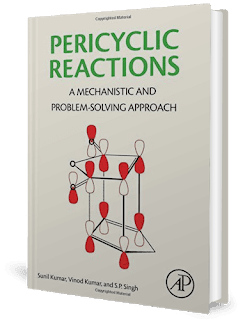| Book Name: | [PDF] Pericyclic Reactions – A Mechanistic and Problem Solving Approach |
| Category: | Organic Chemistry |
| Free Download: | Available |
Pericyclic Reactions – A Mechanistic and Problem Solving Approach :: Ever since the appearance of the classic The Conservation of Orbital Symmetry by Woodward and Hoffmann in 1970, there has been a surge in the publication of many books and excellent review articles dealing with this topic. This was natural as after having established mechanisms of ionic and radical reactions, focus had shifted to uncover the mechanisms of the so-called “no-mechanism reactions.” The uncovering of the fact that orbital symmetry is conserved in concerted reactions was a turning point in our understanding of organic reactions.
It is now possible to predict the stereochemistry of such reactions by following the simple rule that stereochemical consequences of reactions initiated thermally will be opposite to those performed under photochemical conditions. Study of pericyclic reactions, as these are known today, is an integral part of our understanding of organic reaction mechanisms. Despite the presence of many excellent books on this vibrant topic, there was an absence of a book that concentrates primarily on a problem-solving approach for understanding this topic.We had realized during our teaching career that the most effective way to learn a conceptual topic is through such an approach. This book is written to fill this important gap in the belief that it would be helpful to students to have problems pertaining to different types of pericyclic reactions compiled together in a single book.
The book opens with an introduction (Chapter 1), which, besides providing background information needed for appreciating different types of pericyclic reactions, outlines simple ways to analyze these reactions using orbital symmetry correlation diagram, frontier molecular orbital (FMO), and perturbation molecular orbital (PMO) methods. This chapter also has references to important published reviews and articles. Electrocyclic, sigmatropic, and cycloaddition reactions are subsequently described in Chapters 2, 3, and 4, respectively. Chapter 5 is devoted to a study of cheletropic and 1,3-dipolar cycloaddition reactions as examples of concerted reactions. Many group transfer reactions and elimination reactions, including pyrolytic reactions, are included in Chapter 6. There are solved problems in each chapter that are designed for students to develop proficiency that can be acquired only by practice. These problems, about 450, provide sufficient breadth to be adequately comprehensive. Solutions to all these problems are provided in each chapter. Finally, in Chapter 7, we have compiled unworked problems whose solutions are provided separately in the Appendix. The aim behind introducing these unsolved problems is to let the students develop their own skills. Assuming that a student has taken courses in organic chemistry that include reaction mechanisms and stereochemistry, the book is meant to be taught as a one-semester course to graduate and senior undergraduate students majoring in chemistry. One has to remember that a book designed for a one-semester course cannot include all the reactions reported in the literature; rather, only representative examples of each of various reaction types are given. A general index is included, which it is hoped will be of help to readers in searching for the types of reactions related to a particular problem.

Pericyclic Reactions – A Mechanistic and Problem Solving Approach
| Title: | Pericyclic Reactions – A Mechanistic and Problem Solving Approach |
| Editor: | Sunil Kumar Vinod Kumar S.P. Singh |
| Edition: | Illustrated |
| Publisher: | Elsevier Publications |
| Length: | 313 pages |
| Size: | 64.6 MB |
| Language: | English |
Pericyclic reactions : a mechanistic and problem solving approach PDF
Author(s): Kumar, Sunil; Kumar, Vinod; Singh, S. P
Publisher: Elsevier Academic Press, Year: 2016
ISBN: 0128036400
[PDF] Pericyclic Reactions – A Mechanistic and Problem Solving Approach Table Of Contents
Content:
Front Matter,Copyright,To Our Families,PrefaceEntitled to full textChapter 1 – Pericyclic Reactions and Molecular Orbital Symmetry, Pages 1-21
Chapter 2 – Electrocyclic Reactions, Pages 23-75
Chapter 3 – Sigmatropic Rearrangements, Pages 77-144
Chapter 4 – Cycloaddition Reactions, Pages 145-229
Chapter 5 – Cheletropic Reactions and 1,3-Dipolar Cycloadditions, Pages 231-282
Chapter 6 – Group Transfer, Elimination, and Related Reactions, Pages 283-321
Chapter 7 – Unsolved Problems, Pages 323-332
Appendix – Solution Manual, Pages 333-356
Index, Pages 357-370
Related More Books
Thanks For Visiting Our Website https://www.freepdfbook.com To Support Us, Keep Share On Social Media.









![[PDF] Draw Buildings and Cities in 15 Minutes Draw Buildings and Cities in 15 Minutes pdf](https://www.freepdfbook.com/wp-content/uploads/2021/06/Draw-Buildings-and-Cities-in-15-Minutes-218x150.jpg)








![[PDF] Digital Image Processing An Algorithmic Introduction Using Java Digital Image Processing An Algorithmic Introduction Using Java](https://www.freepdfbook.com/wp-content/uploads/2022/06/Digital-Image-Processing-An-Algorithmic-Introduction-Using-Java.jpg)




![[PDF] 43 Years JEE ADVANCED + JEE MAIN Chapterwise & Topicwise Solved Papers 43 Years JEE ADVANCED (1978-2020) + JEE MAIN Chapterwise & Topicwise Solved Papers Physics PDF](https://www.freepdfbook.com/wp-content/uploads/2022/03/43-Years-JEE-ADVANCED-1978-2020.jpg)

![[PDF] Problems in Physical Chemistry for JEE (Main & Advanced) Problems in Physical Chemistry for JEE (Main & Advanced) Free PDF Book Download](https://www.freepdfbook.com/wp-content/uploads/2022/03/Problems-in-Physical-Chemistry-for-JEE-Main-Advanced.jpg)
![[PDF] Engineering Physics (McGraw Hill)](https://www.freepdfbook.com/wp-content/uploads/2021/05/bafc8c2685bb6823a9c56134f7fba5df.jpeg)

![[PDF] Engineering Chemistry By Shashi Chawla](https://www.freepdfbook.com/wp-content/uploads/2022/05/Theory-And-Practicals-of-Engineering-Chemistry-By-Shashi-Chawla-free-pdf-book.jpeg)
![[PDF] Chemistry: An Introduction to Organic, Inorganic & Physical Chemistry Chemistry: An Introduction to Organic, Inorganic & Physical Chemistry](https://www.freepdfbook.com/wp-content/uploads/2022/04/Chemistry-An-Introduction-to-Organic-Inorganic-Physical-Chemistry.jpg)
![[PDF] Essentials of Physical Chemistry Essentials of Physical Chemistry Free PDF Book by Bahl](https://www.freepdfbook.com/wp-content/uploads/2022/04/Essentials-of-Physical-Chemistry-bahl.jpg)
![[PDF] Biological control of plant-parasitic nematodes: soil ecosystem management in sustainable agriculture Biological control of plant-parasitic nematodes: soil ecosystem management in sustainable agriculture](https://www.freepdfbook.com/wp-content/uploads/2022/05/Biological-control-of-plant-parasitic-nematodes-soil-ecosystem-management-in-sustainable-agriculture.jpg)
![[PDF] Human Anatomy: Color Atlas and Textbook Human Anatomy: Color Atlas and Textbook Free PDF Book](https://www.freepdfbook.com/wp-content/uploads/2022/05/Human-Anatomy-Color-Atlas-and-Textbook.jpg)
![[PDF] Concepts of Biology Book [Free Download]](https://www.freepdfbook.com/wp-content/uploads/2022/05/Concepts-of-Biology.jpg)
![[PDF] Essentials of Biology [Free Download] Essentials of Biology Free PDF BOok Download](https://www.freepdfbook.com/wp-content/uploads/2022/05/Essentials-of-Biology-Free-PDF-Book-Downlaod.jpg)
![[PDF] Human Biology Book [Free Download]](https://www.freepdfbook.com/wp-content/uploads/2022/05/PDF-Human-Biology-Book-Free-Download.jpg)